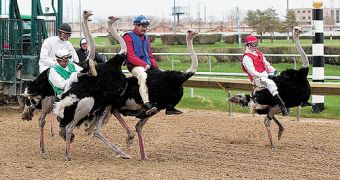1. The African ostrich (Struthio camelus) holds three records: it is the world's largest and fastest running living bird and lays the largest eggs. This bird can reach 160 kg (360 pounds) in weight and 2.75 m (9.2 ft) in height. Males are taller and heavier than females. Still, the African ostriches are not the largest birds ever in history.
The related giant moa (Dinornis robustus), exterminated by the Maori people in New Zealand, could have reached 3 m (10 ft) in height and 250 kg (550 pounds) in weight. In Madagascar, the elephant birds (Aepyiornis maximus), hunted to extinction 500 years ago, were even bigger: 3.3 m (11 ft) tall and 500 kg (1,100 pounds) heavy. Terror birds from South America (which later entered North America) were also larger than ostriches: they reached 2.8 m in height and 400 kg in weight, being ferocious predators with the largest bird skulls ever. 8 to 1 million years ago, thunder birds (Dromornis stiltoni) inhabited Australia - they were 3 m (10 ft) tall and weighed 680 kg (1,500 pounds), being built heavier than a cow. Strangely enough, they were related to geese and ducks!
2. 4,000 years ago, ostriches roamed Syria. 6,000-8,000 years ago, in a savanna-like environment, herds of ostriches roamed what is now Sahara. More recently, the African ostrich became extinct in Northern Africa, Arabia, southern South Africa, surviving just in savannas south of Sahara.
3,000 years ago, the Phoenicians held the Mediterranean monopoly on the trade with painted ostrich eggshells and ostrich feathers, both of which were used as adornments. Romans employed ostriches in their arena games with animals; they also ate their meat in an exquisite dish made of boiled ostrich with sweet sauce.
In South Africa, ostriches are used for defending sheep and cattle herds... The same role is being held by the Australian ostrich, emu, in Australia. Their impressive bodies and attitude even makes thieves fear them. As an example of that, the owner of a deposit of old cars in Lambert, Mississippi, used an ostrich as guard, and the bird proved more effective than two Doberman dogs!
3. This is the only bird having only two toes. The ostrich can reach a top speed of 70 km (42 mi) per hour (as much as a racehorse) and can maintain 50 km (31 mi) per hour on long distances for 15-20 minutes. In full run, the bird's steps measure 5 m (17 ft).
The bird's feet are so strong, that a kick can kill a man. People can avoid the kicks by laying down, but in this case too they are not safe as the bird hits with its beak as well. The chicks reach adult speed at the age of only one month.
4. Most birds do not even have a copulatory organ, but ostriches (and related groups, like kiwi and tinamous), ducks, geese and swans do have. The presence of a copulatory organ in these birds is a sign of primitiveness. Bird penis in flaccid state stays curled up inside the cloaca, like in reptiles and monotreme mammals (platypus and echidna).
5. Ostriches swallow stones (gastroliths) and use them as "gastric mill". The gastroliths make about 1% of the body mass of the ostriches. An adult ostrich consumes 7 kg (16 pounds) of food daily. The ostrich is omnivorous, consuming from plant food to rodents, lizards, bird chicks, turtles and insects. The gut of an ostrich is 14 m (47 ft) long.
6. Eggs are regarded as some of the most fragile things in nature. But when African ostrich eggs were tested, they successfully handled a pressure of 120 kg! Of course, they are the largest eggs: 4.3- 6.4 pounds (or 1.5-2 kg, of which 280 g are represented by the shell) and equal about 36 chicken eggs. Crocodiles, even if they can reach up to a ton, lay small eggs compared to their mass, about the same size of the goose egg. Bushmen use ostrich eggshells to keep fresh water.
The eggs of the Aepyiornis were even larger: up to 12,5 kg (27 pounds), 32 cm (13 inch) tall and 22 cm (9 inch) wide. A dinosaur egg found in Argentina was 1.6 m (5.3 ft) tall and 80 cm (2.6 ft) wide.
7. In the wild, ostriches can live up to 30 years; when in captivity, their lifespan increases to even 70 years.

 14 DAY TRIAL //
14 DAY TRIAL //